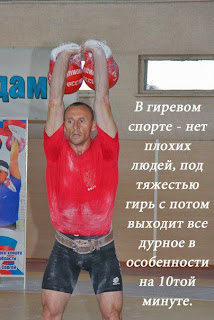Last
weekend was the first Girevoy Sport event ever hosted at QCrossfit in
Randolph, NJ. Gym owner and organizer Eric Reyelt did the amazing by getting all of us
out-of-town people in to the event and also preparing his own team, QKB Club. Co-hosted
and officiated by IKSFA, this event was attended by lifters from several U.S.
locations and clubs, a team from Kazakhstan, and World Champion Kettlebell
Juggler, Coach Oksana Nikifor. The greatest gift for me was the chance to meet with my coach, Sergey Rudnev, for the first time in a year!
This
event was an end-of-year gimme to some of us striving for specific ranks. Coach
Nikifor dazzled us with an incredible juggling routine at the start of the
event. Though there were a few surprises, (the most obvious being random
glitches in the electronic timer technology, and a few clerical errors that
left the correct medal recipients unrecognized at the awards ceremony)
participating lifters showed good sportsmanship and support for each other
throughout.
Many
personal bests were achieved, including
Tatyana Potemkina of Team Kazakhstan (72kg
weight class)
World
Record in Women's 24kg Snatch (170 reps)
Jeff Martone of Team IKSFA USA (100kg weight
class)
North American Record in Men's 24kg Snatch (234
reps)
The
Biathlon turn out was down-played due to a whole team withdrawal at the
last-minute. Apparently they did not want to risk life and limb in the
New Jersey snowstorm. Two lifters, one male and one female, did perform the double event and gave us a great
demonstration of the mental fortitude required of GS Biathletes. Sergey Karpenko of Team Kazakhstan 32kg Biathlon (score of 179.5: Jerk 90 + Snatch
179), and Julia Lui, under coach Lorna Kleidman 16kg Biathlon (score of 172: Jerk 145 + Snatch
199).
These two
shared the first and last flights with an intrepid first time lifter and the only competitor with two single events, Aaron Lassiter of Team OKC: 16kg Men’s Long Cycle (93 reps); 16kg Snatch Only (213 reps). These three kicked off the event in the first flight and finished it 3 hours later.
Long
Cycle dominated the day with 35 participants.
A majority of the Men’s division
lifted 16kg LC in a demonstration of the fun and easy nature of this
event. My teammate Slava Barsuk, under Coach Denis Vasilev, took the opportunity to practice the faster pacing required for greater achievements planned for early next year, lifting Men's 16kg LC x 97. Heavier loads were
represented, and top numbers turned in by Mike Sanders of Team NJ KC with
20kg LC (81 reps), and Juan Pellot of Team KB Athletics with 24kg LC (69 reps).
 |
| With Sergey Rudnev seconds after the set. |
Among
the women we saw a range of weight loads from 8 – 20kg, again, representing amateur athletes starting into the sport, logging personal records with
non-professional weight loads, or (like myself) making use of the
soon-to-expire IKSFA rank table. I took this last opportunity to achieve MS
with 20kg LC (123 reps). My
student, avid One-Hour Long Cycler Kimberly Hodes took the moment to earn her
Rank 1 with 12kg LC (120). Meredith Riccardi, under the guidance of Coach Mike, put up the highest
Kudos to my Colorado team mate Alison Zemanek, under Coach Slava Barsuk, on her first major event! She achieved Rank 1 her first time out with 16kg LC (88 reps).
There
were 11 Snatch Only lifters and every one of them seemed to have something to
get done.
The lowest rep count of this group in both divisions earned the lifter MS rank. Marty Farrell of Team IKSFA USA
put up 32kg x 109 reps. The highest rep count for Men’s Snatch Only is the
above mentioned by Jeff Martone, 234 reps. Coach Sergey Rudnev of Team IKSFA
Russia, played into the new international ranking table with a 28kg set
yielding 167 reps.
The
Women’s division kept up the pace, the highest coming from Lorna
Kleidman of Team IKSFA USA, lifting 16kg x 232. Her student, Avery Wittkamp snatched
20kg for 119 reps and a rank of CMS. Amazingly, this respectable effort was the
lowest Snatch Only rep count of the Women’s division.
Starting
in 2014 all AKA/IUKL affiliate organizations will be using the new table, which can be found here.
 |
| From Colorado, Kimberly, Alison, Slava and me. |
Placement awards for the Holiday Open were given based on
co-efficient.* This seemed to have been a surprise to many participants, who
anticipated the long ceremony of first, second and third place for each weight
class/weight load based on rep count for each event. Last weekend's IKSFA event concluded
with a fairly brief awards ceremony. Trophies were given for Men and Women for best in all events: Biathlon; Professional and Amateur Long Cycle; Professional and
Amateur Snatch Only; medals given for first, second and third co-efficient factor in all events; Best Absolute Professional and Amateur Male and Female lifter (I believe this is based on rep count regardless of co-efficient); and medals given for ranks CMS, MS and MSIC.
*The co-efficient factor is the result of the entire weight
load times the number of reps divided by the lifter’s body weight. With this
method of scoring a lifter using less kettlebell weight may prevail over one
with a heavier load.






















